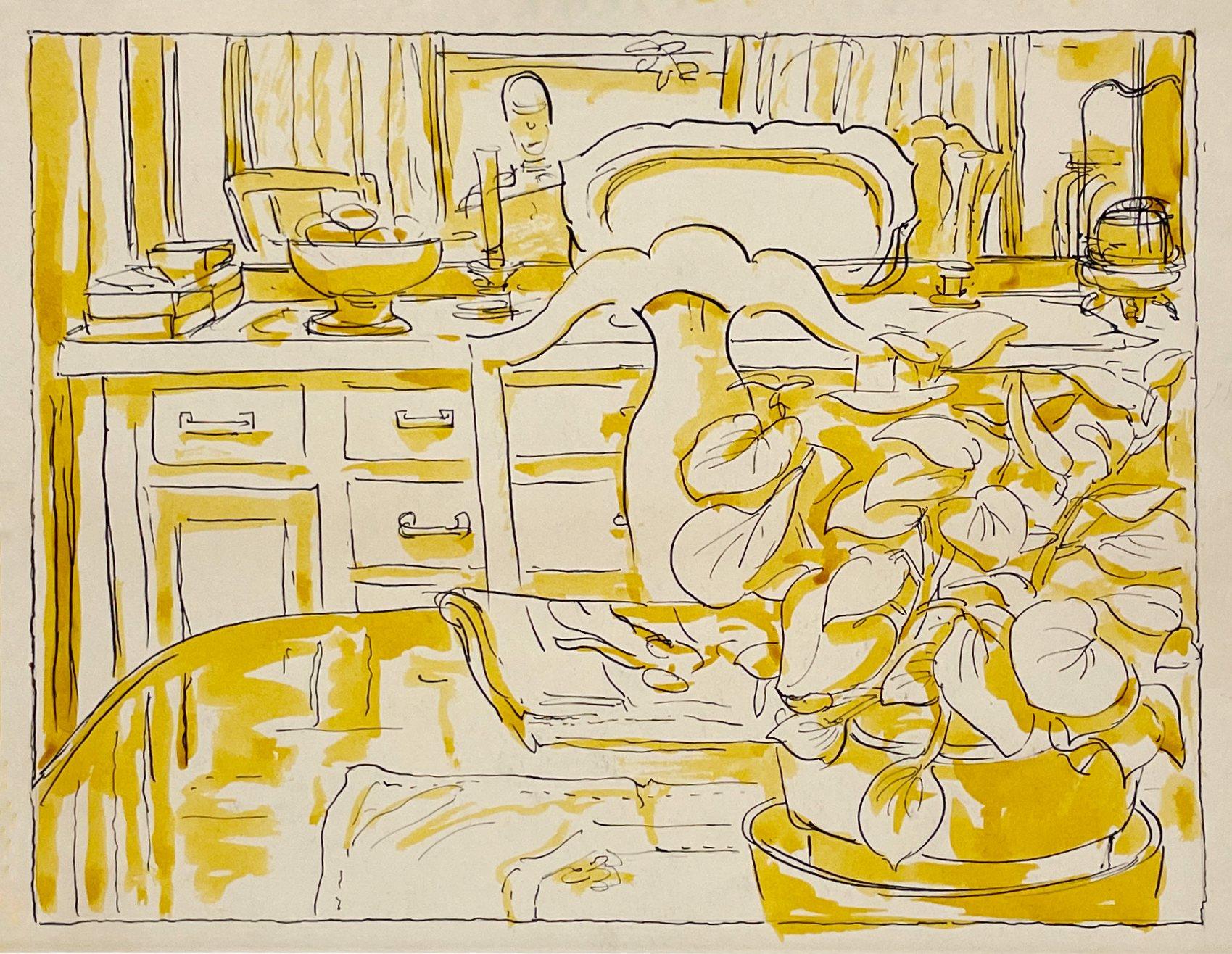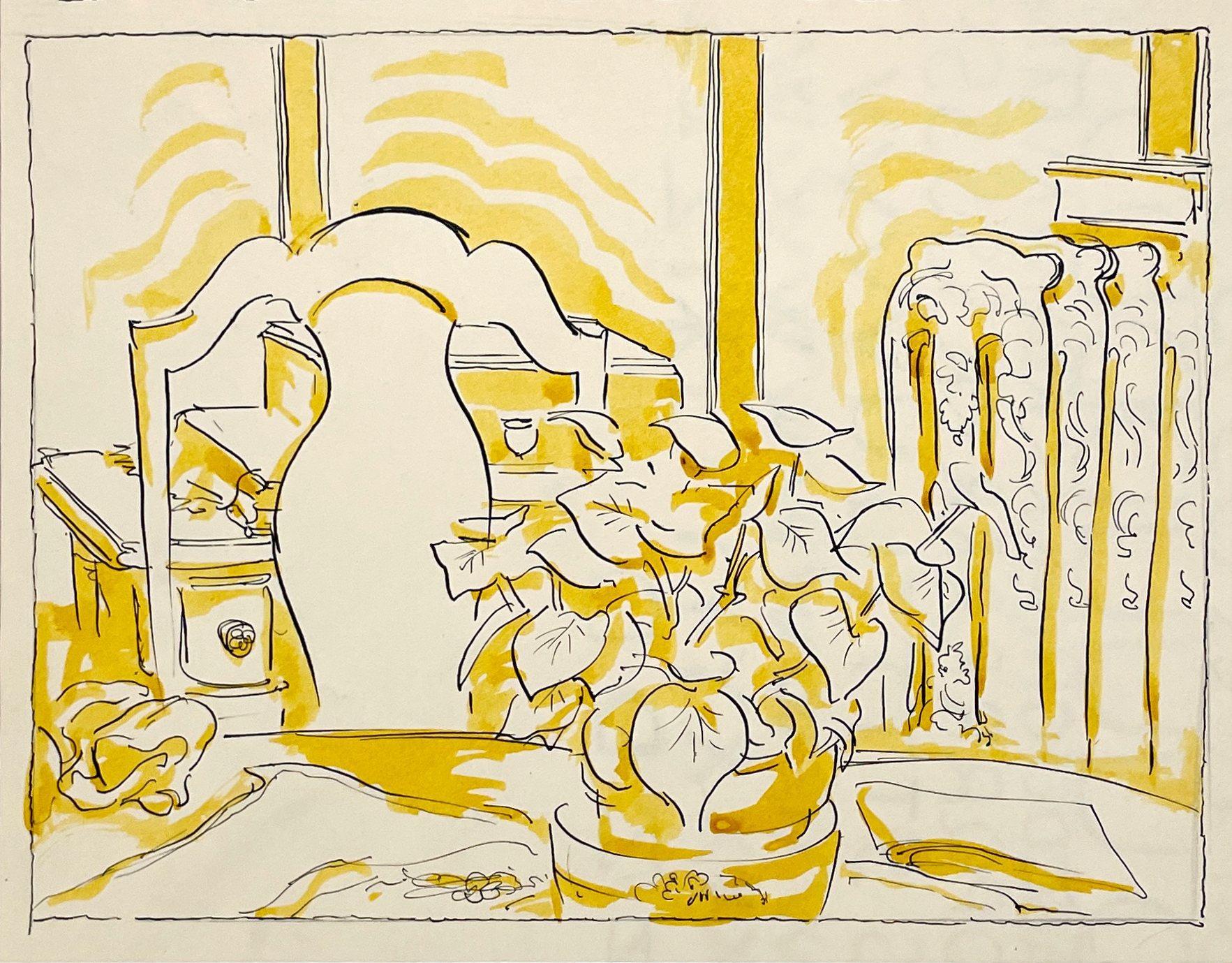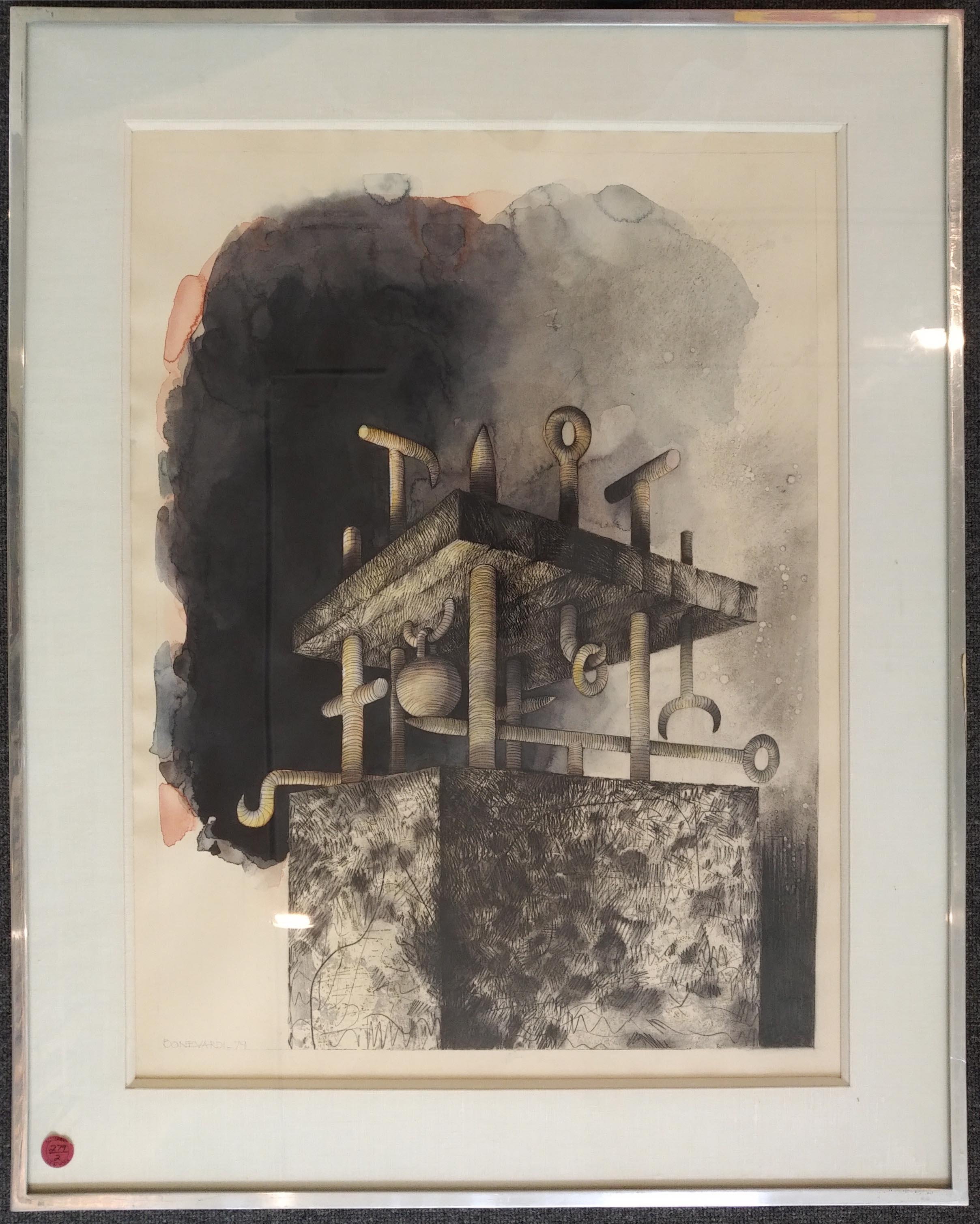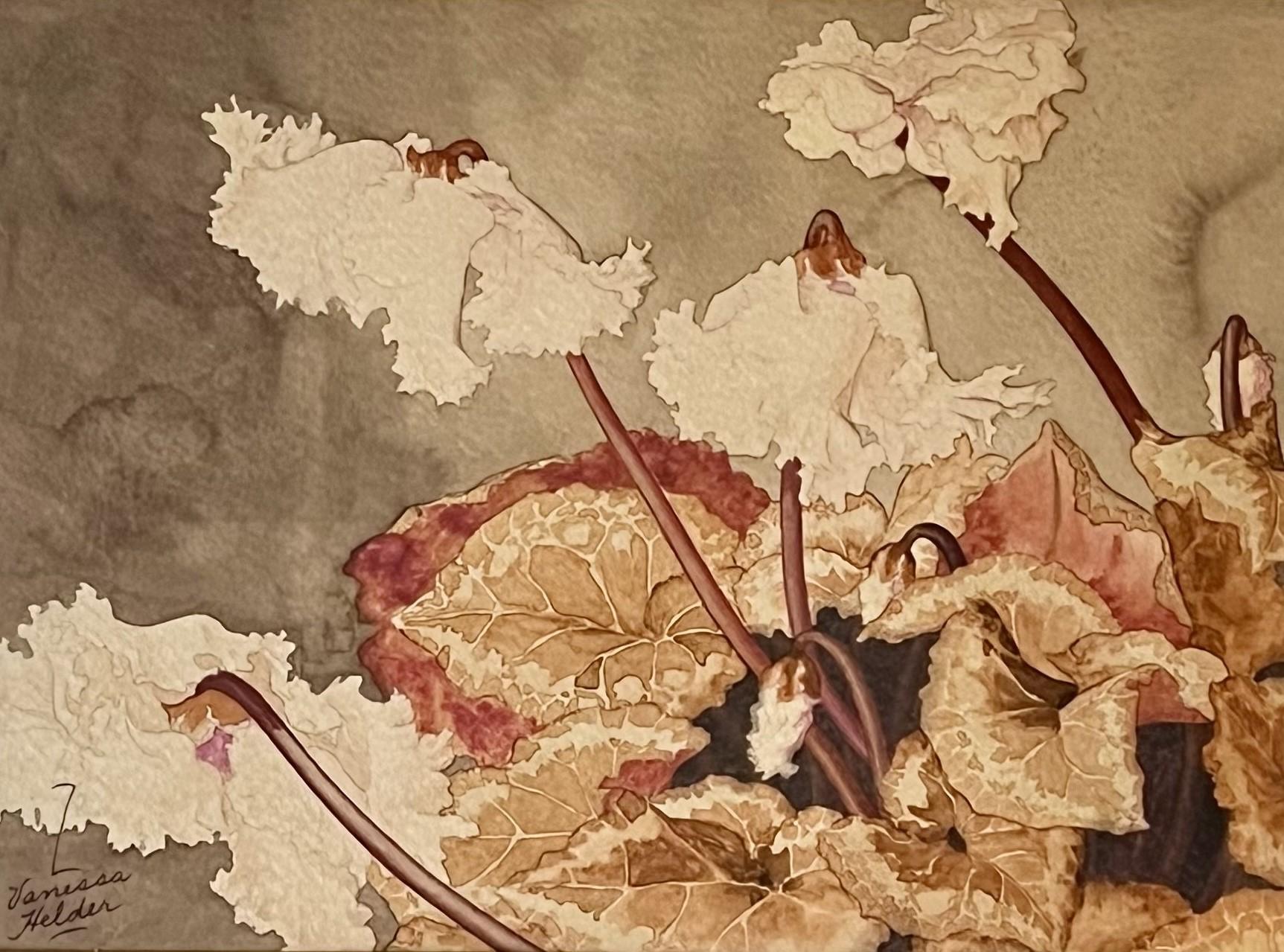Items Similar to Garden Flowers
Want more images or videos?
Request additional images or videos from the seller
1 of 8
Charles DemuthGarden Flowers1933
1933
About the Item
Charles Demuth was one of the most complex, talented, and deeply sensitive artists of the American modern period. Whether he was painting floral still lifes, industrial landscapes, or Turkish bathhouses, art was, for Demuth, fraught with personal meaning. A fixture of the vanguard art scene in New York, Demuth navigated the currents of Modernism, producing some of the most exquisite watercolors and original oil paintings in twentieth-century American art.
Demuth was born in Lancaster, Pennsylvania, the only child of a well-to-do family. He had an awkward and introverted childhood shaped by a childhood illness, Perthes, a disease of the hip that not only left him permanently lame, but, as part of the “cure,” bedridden for two years in the care of his mother. This long period of incapacitation had a deep impact on Demuth, who came to see himself as an invalid, an outsider who was different from everyone else. It was perhaps during this period of indoor confinement that his keen interest in art developed. Several relatives on his father’s side had been amateur artists, and, following his convalescence, his mother encouraged his artistic pursuits by sending him to a local painter for instruction. The majority of his early pictures are of flowers, a subject for which Demuth maintained a lifelong passion.
Following high school, Demuth enrolled at the Drexel Institute of Art in Philadelphia, a school renowned for its commercial arts program. He advanced through the program rapidly, and, in 1905, at the encouragement of his instructors, he began taking courses at the Pennsylvania Academy of the Fine Arts. The two leading teachers then at the Academy were William Merritt Chase and Thomas Anshutz. Anshutz, himself a former student of Thomas Eakins, was well liked by his students, and is best known as the teacher of Robert Henri, John Sloan, and several of the other artists of the Ashcan School. Demuth, too, adopted a similar idiom, working in a controlled, realistic manner while at the Academy, where he remained until 1910.
In 1907, Demuth made his first trip to Europe, staying in Paris. He spent time on the periphery of the art scene composed of the numerous American artists there, including John Marin and Edward Steichen. He returned to Philadelphia five months later, and immediately resumed courses at the Academy. Despite his introduction to advanced modern styles in Europe, Demuth’s work of this period retains the academic style he practiced before the trip. It wasn’t until he had summered at New Hope, Pennsylvania, in 1908 and 1911, that his style began to evolve. New Hope was a prominent American Impressionist art colony whose members were largely affiliated with the Pennsylvania Academy. Demuth dropped the conservative tone of his style and adopted a freer and more colorful palette.
Although he remained based in Philadelphia, Demuth frequently went to New York during this period. Many of the same American artists of the Parisian art scene Demuth had encountered on his earlier European trip now formed the nucleus of New York’s avant-garde, which centered around Alfred Stieglitz’s 291 gallery. It wasn’t long before Demuth began to apply modernist-inspired strategies to his work. He was particularly influenced by the watercolor work of John Marin, also a former student of Anshutz, whose bold use of color in the medium Demuth freely adapted into looser washes of color.
In 1912, Demuth again left for Paris, this time studying in the Académie Moderne, Académie Colorossi, and Académie Julian. In Paris Demuth met the American modernist Marsden Hartley. Hartley, a principal figure in the expatriate art circle, acted as a mentor to Demuth, and introduced him to the wide array of modern styles currently practiced in Europe. Hartley also introduced Demuth to many of the members of the Parisian avant-garde, including Gertrude Stein. Demuth was an aspiring writer, and he spent many hours in conversation with Stein. He wrote extensively during this period, and published two works shortly after his return to America. He also developed an interest in illustrating scenes from literary texts. From 1914 to 1919, Demuth produced a series of watercolors of scenes from books such as Emile Zola’s Nana and Henry James’s The Turn of the Screw.
Upon his return to America, Demuth settled in New York. In 1914, Demuth had his first one-man show at Charles Daniel’s gallery, which promoted emerging modern American artists, including Man Ray, Rockwell Kent, Yasuo Kuniyoshi, Stuart Davis, and Max Weber. Demuth drew closer to the artistic vanguard in New York, becoming friends with many in the Stieglitz and Daniel circles, including Georgia O’Keeffe, Marcel Duchamp, Carl Van Vechten, and Edward Fiske.
New York’s cosmopolitan atmosphere and active nightlife appealed greatly to Demuth. In a sketchy style well suited to watercolor, he painted many vaudeville and circus themes, as well as nightclub, café, and bathhouse scenes. Often with Duchamp, Demuth took part in an urban subculture replete with nightclubs, bars, drugs, and sexual permissiveness, which, for a homosexual artist like himself, allowed room for previously unattainable personal expression. Demuth’s pictures of sailors, bathhouses, and circus performers embody a sensual and sexual undercurrent, expressing the artist’s sense of comfort and belonging in the bohemian subculture of New York.
Simultaneously, Demuth deepened his interest in floral pictures, painting these almost exclusively in watercolor. His style evolved from the broad color washes of his earlier pictures to more spare, flattened, and sinuous compositions, inspired by the drawings of Aubrey Beardsley and other artists of the Aesthetic Movement. Demuth’s flower watercolors are moody and atmospheric, sensuous and elegant, introspective and yet full of expressive power. Moreover they are beautiful, and are unequivocally among the finest still lifes in American art. Despite numerous subsequent artistic undertakings that led him in a variety of directions, Demuth never stopped painting flower pictures, ultimately adding fruits and other still-life objects to his repertoire.
In 1916, Demuth began to develop a style later known as Precisionism, a form of landscape painting infused with Cubism, in which space is divided into precisely drawn geometric regions of color. Demuth first began to paint the landscape in an appropriated Cubist mode while on a trip with Hartley to Bermuda. In these early landscapes, in which the curvilinear forms of trees intersect the geometrically articulated architectural forms, Demuth explored ideas that shaped the future development of modernism in America.
The full realization of Demuth’s explorations came after his return to America in 1917, when he turned his attention to industrial subjects. These works derive from a “machine aesthetic,” espoused by New York artists such as Francis Picabia, Joseph Stella, Albert Gleizes, and Duchamp, by which artists viewed machines as embodying mystical, almost religious significance as symbols of the modern world. Rather than painting the skyscrapers and bridges of New York as did most of his like-minded contemporaries, Demuth returned to his home town of Lancaster, where he painted factories and warehouses in a Precisionist idiom. The titles for these pictures are often contain literary references, which serve as clues for the viewer to aid in the decoding of the artist’s meaning.
In 1923, Demuth planned a series of abstract “poster portraits” of his friends and contemporaries in the New York art and literary scene. In these “portraits,” Demuth combined text and symbolic elements to evoke the essential nature of his sitters’ distinguishing characteristics. In this fashion, he painted portraits of such artists as Georgia O’Keeffe, John Marin, and Arthur Dove. His most famous poster portrait, I Saw the Figure 5 in Gold (1928, The Metropolitan Museum of Art, New York), represents his friend, poet and physician William Carlos Williams, and is titled after Williams’s poem, “The Great Figure.” Demuth’s plans to complete and exhibit a series of portraits were mostly unsuccessful, however, and he abandoned the project in 1929.
By 1927, Demuth returned to Lancaster architectural subjects and reached the apex of his Precisionist style, producing the paintings for which he is best known, including the iconic My Egypt (1927, The Whitney Museum of American Art, New York). His floral pictures of the period, including the present picture, exhibit elements of his late Precisionist aesthetic, in which the flowers are more strongly rendered than in his earlier pictures. Returning to Beardsley as a source, these late pictures are both more forceful and expressive than earlier works. Garden Flowers, painted in 1933, is one of Demuth’s relatively rare late-career works. The artist found it increasingly difficult to work in these last years as he began to succumb to the diabetes that ultimately took his life in 1935.
According to family tradition, the present still life of Garden Flowers was purchased from Demuth’s mother, Augusta, by a Manasquan, New Jersey, collector in the 1930s. This collector then gave it as a gift to another private collector, with whom it remained until 2004.
- Creator:Charles Demuth (1883-1935, American)
- Creation Year:1933
- Dimensions:Height: 13.88 in (35.26 cm)Width: 10 in (25.4 cm)
- Medium:
- Movement & Style:
- Period:
- Condition:
- Gallery Location:New York, NY
- Reference Number:
About the Seller
5.0
Recognized Seller
These prestigious sellers are industry leaders and represent the highest echelon for item quality and design.
Established in 1952
1stDibs seller since 2010
32 sales on 1stDibs
Typical response time: 6 hours
Associations
Art Dealers Association of America
- ShippingRetrieving quote...Ships From: New York, NY
- Return PolicyThis item cannot be returned.
More From This SellerView All
- Three FlowersBy Joseph StellaLocated in New York, NYJoseph Stella was a visionary artist who painted what he saw, an idiosyncratic and individual experience of his time and place. Stella arrived in New York in 1896, part of a wave of ...Category
20th Century American Modern Still-life Drawings and Watercolors
MaterialsPaper, Crayon
- Two Wood Ducks on a Flowering BranchBy Joseph StellaLocated in New York, NYJoseph Stella was a visionary artist who painted what he saw, an idiosyncratic and individual experience of his time and place. Stella arrived in New York in 1896, part of a wave of Italian immigrants from poverty-stricken Southern Italy. But Stella was not a child of poverty. His father was a notary and respected citizen in Muro Locano, a small town in the southern Appenines. The five Stella brothers were all properly educated in Naples. Stella’s older brother, Antonio, was the first of the family to come to America. Antonio Stella trained as a physician in Italy, and was a successful and respected doctor in the Italian community centered in Greenwich Village. He sponsored and supported his younger brother, Joseph, first sending him to medical school in New York, then to study pharmacology, and then sustaining him through the early days of his artistic career. Antonio Stella specialized in the treatment of tuberculosis and was active in social reform circles. His connections were instrumental in Joseph Stella’s early commissions for illustrations in reform journals. Joseph Stella, from the beginning, was an outsider. He was of the Italian-American community, but did not share its overwhelming poverty and general lack of education. He went back to Italy on several occasions, but was no longer an Italian. His art incorporated many influences. At various times his work echoed the concerns and techniques of the so-called Ashcan School, of New York Dada, of Futurism and, of Cubism, among others. These are all legitimate influences, but Stella never totally committed himself to any group. He was a convivial, but ultimately solitary figure, with a lifelong mistrust of any authority external to his own personal mandate. He was in Europe during the time that Alfred Stieglitz established his 291 Gallery. When Stella returned he joined the international coterie of artists who gathered at the West Side apartment of the art patron Conrad Arensberg. It was here that Stella became close friends with Marcel Duchamp. Stella was nineteen when he arrived in America and studied in the early years of the century at the Art Students League, and with William Merritt Chase, under whose tutelage he received rigorous training as a draftsman. His love of line, and his mastery of its techniques, is apparent early in his career in the illustrations he made for various social reform journals. Stella, whose later work as a colorist is breathtakingly lush, never felt obliged to choose between line and color. He drew throughout his career, and unlike other modernists, whose work evolved inexorably to more and more abstract form, Stella freely reverted to earlier realist modes of representation whenever it suited him. This was because, in fact, his “realist” work was not “true to nature,” but true to Stella’s own unique interpretation. Stella began to draw flowers, vegetables, butterflies, and birds in 1919, after he had finished the Brooklyn Bridge series of paintings, which are probably his best-known works. These drawings of flora and fauna were initially coincidental with his fantastical, nostalgic and spiritual vision of his native Italy which he called Tree of My Life (Mr. and Mrs. Barney A. Ebsworth Foundation and Windsor, Inc., St. Louis, illus. in Barbara Haskell, Joseph Stella, exh. cat. [New York: Whitney Museum of American Art, 1994], p. 111 no. 133). Two Wood Ducks...Category
20th Century American Modern Still-life Drawings and Watercolors
MaterialsColor Pencil
- Stiff Life of Peaches, Plums, and GrapesBy William HoughLocated in New York, NYThe Victorian still-life painter William Hough began his career working in Coventry and later moved to London. He exhibited flower and fruit still lifes at the Royal Academy and at t...Category
Late 19th Century Realist Still-life Drawings and Watercolors
MaterialsPaper, Watercolor
- African Agapanthus, or Blue Lily, a native of the CapeBy Frances Jauncey KetchumLocated in New York, NYSigned (at lower right): FJKCategory
Early 19th Century American Realist Still-life Drawings and Watercolors
MaterialsWatercolor
- Bitter Quassia, a native of SurinamBy Frances Jauncey KetchumLocated in New York, NYSigned (at lower right): FJKCategory
Early 19th Century American Realist Still-life Drawings and Watercolors
MaterialsWatercolor
- Annual Lavatera a native of SpainBy Frances Jauncey KetchumLocated in New York, NYSigned (at lower right): FJK [partial]Category
Early 20th Century American Realist Still-life Drawings and Watercolors
MaterialsWatercolor
You May Also Like
- Still Life at a Table, Study in Yellow by Artist Harold HaydonBy Harold HaydonLocated in Chicago, ILA ca. 1931 delightful still life at a table; a study in yellow by artist Harold Haydon. Harold Emerson Haydon was born in Fort William, Ontario, Canad...Category
1930s American Modern Still-life Drawings and Watercolors
MaterialsPaper, Ink, Watercolor, Pen
- Still Life at a Table, Study in Yellow by Artist Harold HaydonBy Harold HaydonLocated in Chicago, ILA ca. 1931 delightful watercolor still life at a table; a study in yellow by artist Harold Haydon. Harold Emerson Haydon was born in Fort William, Ont...Category
1930s American Modern Interior Drawings and Watercolors
MaterialsPaper, Ink, Watercolor, Pen
- Still Life at a Table, Study in Yellow by Artist Harold HaydonBy Harold HaydonLocated in Chicago, ILA ca. 1931 delightful watercolor still life at a table; a study in yellow by artist Harold Haydon. Harold Emerson Haydon was born in Fort William, Ont...Category
1930s American Modern Still-life Drawings and Watercolors
MaterialsPaper, Ink, Watercolor, Pen
- UNTITLED No. 26Located in New York, NYAvant-Garde ArgentineCategory
1970s American Modern Still-life Drawings and Watercolors
MaterialsPaper, Conté, Charcoal, Watercolor, Pencil
- Tribute to Morandi #29By Bob Stuth-WadeLocated in Dallas, TXBob Stuth-Wade: Tribute to Morandi, 2018 "Life is what happens while I'm thinking of something else." "Driving. Listening to the radio. Talking on the phone. Thinking of where I'm ...Category
2010s American Modern Still-life Drawings and Watercolors
MaterialsPaper, Ink, Watercolor
- Untitled (Floral Still Life)By Zama Vanessa HelderLocated in Los Angeles, CAThis work is part of our exhibition America Coast to Coast: Artists of the 1940s. Untitled (Floral Still Life), ca. 1940s, watercolor on paper, signed lower left, 10 x 13 inches (i...Category
1940s American Modern Drawings and Watercolor Paintings
MaterialsPaper, Watercolor
Recently Viewed
View AllMore Ways To Browse
Flower Base
Flower Time
Flower World
A Time For Flowers
Through The Flower
Garden Flower
Flower Inspired
Painterly Flowers
Full Flower
Flowers In Space
Artistic Flowers
Garden Flowers Painting
Flower Garden Paintings
Modern Tree Of Life
Passion Flower
Man With Flower
By Flowers Vintage Paris
Flowers Frame Composition





